- Opalescent Glass – fusing of colors
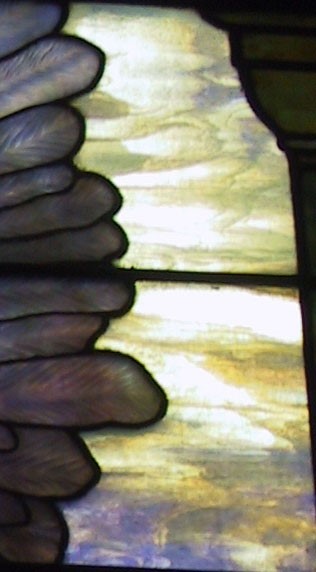
From “Angel of Victory”
Opalescent glass is a generalized term for clear and semi-opaque pressed glass, cloudy, marbled, and sometimes accented with subtle coloring all combining to form a milky opalescence in the glass.
This opalescence is also created in the glassmaking by alternating heating and cooling of the glass and with the addition of chemical additives to create the desired effect.
John LaFarge, a Tiffany rival, created this technique, but Tiffany furthered and popularized its use.
- . Drapery Glass – folds
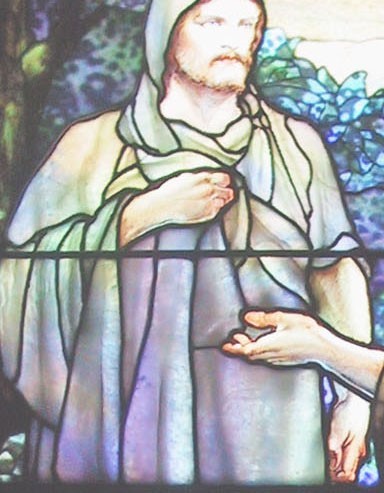
From “Road to Emmaus”
Glass while molten thrown onto an iron table and rolled into a disk. The glassmaker armed with tongs manipulated the mass andby taking hold of it from both ends like dough and pulling and twisting till it fell into folds.
The resulting texture gave volume to the robes of figures or the petals of a flower and increased the modulation of light. We see it here in the folds of the clothing.
- Plated – layering of glass by soldering one or more pieces of glass over another
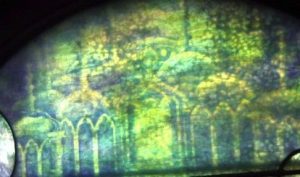
From “Angels with Trumpet and Incense”
There are several advantages. It allows you to modify glass colors and textures and superimpose images. It helps to create a 3 dimension effect for depth.
- Mottled or Spotted Glass –
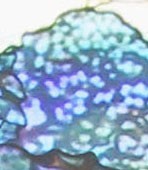
From “Road to Emmaus”
It resulted from a crystallization created by the addition of fluorine in the firing process of glass, and the rolling process carried out on the molten glass, which produced variations in the density and size of the spots.
- Fractured or confetti glass

From “Angel of the Resurrection”
Fractured glass is embedded glass with tiny paper-thin flakes in different colors. It was made by breaking vessels blown thin, spreading the shards on a marver and embedding them into the molten glass. These multicolored, irregularly shaped fragments produced visually complex effects, which were perfect for representing foliage. Typically this glass was used for landscapes.
- Marbleized Glass
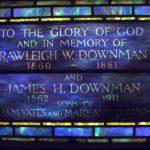
From “Road to Emmaus”
This technique was commonly used in inscriptions as shown above.
- Ripple Glass
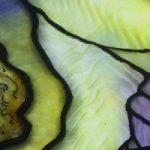
From “Angel of the Resurrection”
Ripple glass refers to a sheet of textured glass with marked surface waves. Tiffany made use of such textured glass to represent, for example, water or leaf veins.
The texture is created during the glass sheet-forming process. A sheet is formed from molten glass with a roller that spins on it, while traveling forward. Normally the roller spins at the same speed as its own forward motion, and the resulting sheet has a smooth surface. In the manufacture of rippled glass, the roller spins faster than its own forward motion. The rippled effect is retained as the glass cools.
- Enamel Paint over the glass – It was common to use enamel paint on the faces and arms for a realistic view.
Enamels are soft powdered colored glass that is mixed with a medium and painted onto the glass with a brush. When the medium is dry, the glass is placed in a kiln for firing.
This was one of 4 ways to color glass
- Pot Metal – It was heated in a large crucible and metallic oxides were added for color.
- Flashing- made by dipping a ball of semi-molten white colorless glass into molten colored glass which, when blown and flattened, results in a less intense color because it will be white on one side and colored on the other.
- Staining – coloring the surface of glass by the application of silver sulfide or silver chloride, which is then fired at a relatively low temperature.

From “Road to Emmaus”
- Copper foil method – use of copper foil tapes instead of lead came to hold glass panes together and enabled three dimensional objects, such as stained glass lights. Steps A. the edges of all the glass pieces are wrapped in the foil. The foil is then burnished or put onto all three sides. Instead of putty, flux is applied very sparingly to all of the visible copper. B. The pieces are then soldered together. . Solder is put across every visible spot of foil. C A patina is then put on to finish the piece by darkening the solder. This also allows for the black edging look to occur, which would normally take quite a bit of time with lead.
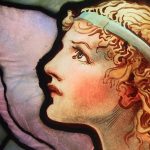
From “Angels with Trumpet and Incense”
- Jewels
These are pieces of hot glass that is press-molded into a jewel like shape. Note the middle of the flowers

From “Angel of the Resurrection”
